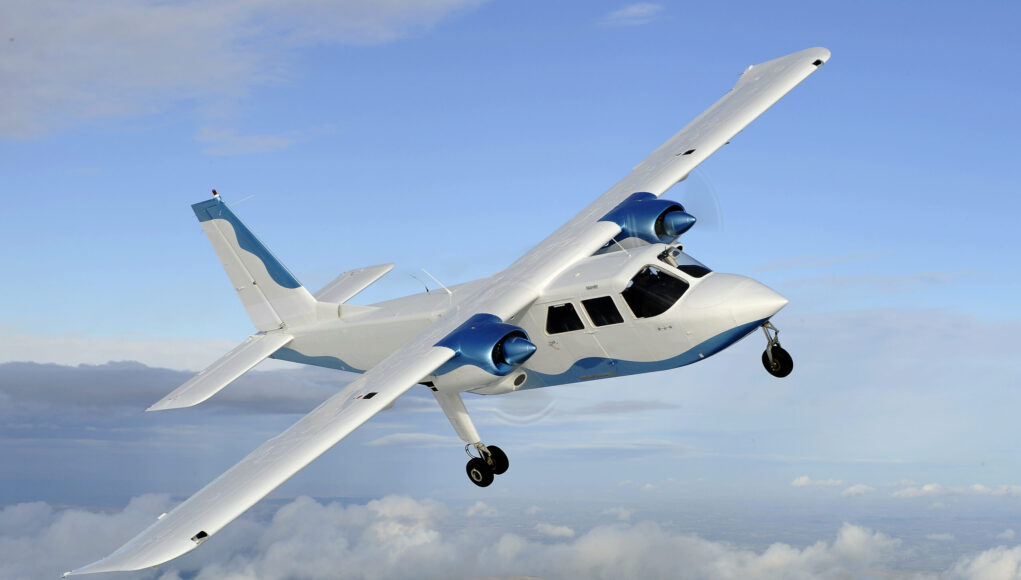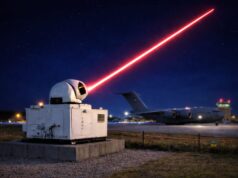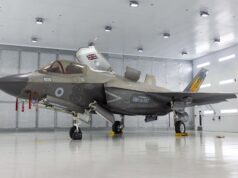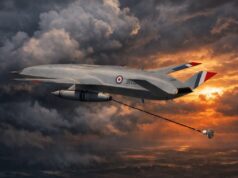Britten-Norman have announced that they will work with Blue Bear Systems to automate the Islander aircraft.
The aircraft serves in a variety of roles from passenger and cargo transport to medevac and search & rescue.
“Its adaptability, as well as short take-off and landing abilities, has made it the backbone of communities around the world. The project’s first milestone will be to demonstrate single pilot operations with an autonomous co-pilot providing access to more information and assistance than human perception alone can provide.”
The firm also say that the project’s breakthroughs will allow regional air transport to compete with traditional ground services.
“A zero-carbon aircraft that was able to offer higher frequency services, with more day return scheduling and reduced travel times, could become a significant rival to road and rail journeys. This is critical to the UK’s levelling up agenda, improving transport links between the UK’s regions and cities.”
Members of the project, led by UAV specialist Blue Bear Systems, include hydrogen-electric powertrain developers ZeroAvia and green hydrogen experts Protium, satellite communications authority Inmarsat, regional airline Loganair, regional airport group Highlands & Islands Airports Limited, award-winning architect firm Weston Williamson + Partners, global vehicle hire company Fleetondemand and Edinburgh Napier University.
Lara Harrison, Business Development Director of Britten-Norman, said:
“We are looking forward to working closely with Blue Bear Systems to produce the next generation automation for the Islander. Project HEART represents an important step towards the future of aviation in the UK. I look forward to the consortium working together to revitalise and expand the UK’s regional air transport network.”
Describing Project HEART, Britten-Norman say:
“HEART aims to transform air transportation in the UK for cargo and passengers. The project will focus on transforming 9 – 19 passenger capacity aircraft and utilise up to 100 licensed General Aviation airfields around the UK. The partnership identified the main challenges facing regional air transport, aiming to address them during the project. Each member of HEART will focus on combating a specific issue including cutting carbon emissions to zero, reducing costs to operators and passengers, expanding regional airports and increasing the frequency of services.”














Forgetting the automation bit of this story (which is what its all about – I know), the Britten-Norman BN-2 Islander has a stall speed of 40kt, needs 370m take off run and 300m landing run (presumably those numbers assume 0 windspeed).
It has a 2500kg capacity, 10 passengers, cruise speed 130kt, range 750nmi, ceiling 13000ft (wikipedia).
QE & POW are 280m long and can give a guaranteed 25-30kt headwind for flight ops (equating to stall speed +10-15kt).
Is it not possible for this aircraft, or one like it, to be operated from the carriers? Instead of expensive and complex Ospreys, wouldnt this be a whole lot simpler for perhaps CoD, IFR, Crowsnest perhaps, etc?
If not this aircraft itself, then is there not scope to consider a similar (maybe smaller, higher performance) fixed wing alternative? DOes it always have to be rotary wing or V-STOL, what’s so wrong with short field fixed wing as an option?
I guess the answer is yes but someone with more knowledge could add more, you’d want to have traps and angled deck. Not sure if the Islanders undercarriage would up to it and the airframe would need strengthening. They’ve landed a C130 on a carrier so its theoretically possible (check the youtube video). I believe BAe had proposed the 146 for COD, that would have been interesting!
Although used in remote locations and on beach landings I suspect that some serious navalisation would be required – corrosion protection/prevention, wing folding for easy storage etc
Yeah good points. Given the landing gear is on the wing the wing would likely need work anyway.
an Islander has a takeoff distance of 50 yards with full load and a strong headwind, i.e. carrier speed! been there done it! took of across the runway airborne before centreline, as for landing no traps would be needed and no strengthening as it was designed for rough field operation.
I’m not sure it would be structurally strong enough to take the sustained beating a carrier based fixed wing aircraft would be subjected to.
I’d agree but removing the pilot would and associated systems would free up weight to reinforce the air frame and landing gear. Having said that, there’s probably better starting points if you wanted to go this route.
I think the idea is sound because is what you are talking about is a full sized drone with a massive reduction in running costs. The least they could do would be to trial it. Maybe a Trilander layout would give it even more ooumpf to get it to height. Tri engine what is there not to like?
I agree.
Carrier landing planes need to be very heavily ruggedised. The deck to wheel forces are big: the runway can move quite hard against the wheels both in landing and take off. Plus you would need to slam it down on the deck for the brakes to work from the off.
It would be the addition of the ski jump forces and the motion forces that would be the issue.
Also it doesn’t really have the installed power to do proper radar. Once you get into re-engining a plane and structurally reinforcing it things get complex/expensive pretty quickly.
The UAV angle is the way to go on this: the commercial sector is producing some products that are getting close. And I am pretty confident that we will see UAV’s working with Merlin/CrowsNest and then taking over from Merlin by the mid 2020’s.
This then allows the Merlin’s to be redeployed where manned flight is absolutely required.
I have wondered about this as an option for the QE class. The problem is that the aircraft would need the whole length of the flight deck to take off or land. This would be difficult to fit in with ski ramp launch and vertical landings of F35 and helicopters.
I presume however that a purpose designed fixed wing drone could one day replace crowsnest. It won’t be as cheap as an Islander though!
We could do what you suggest but the question is why would we? A modern turboshaft-electric hybrid platform offers vertical takeoff combined with wings for long range and economy in flight and could be used from any vessel with a flight deck. Also a more flexible platform for commercial passenger or cargo use that would drive volume and reduce cost.
One concept example is the Rolls-Royce EVTOL project from a couple of years back https://www.rolls-royce.com/media/our-stories/discover/2018/blue-sky-thinking-rr-unveils-evtol-concept-at-farnborough-airshow.aspx
And another similar propulsion example that’s purely unmanned and being developed both for cargo carrying in Alaska between remote Inuit settlements and being considered by the US military.
https://www.sabrewingaircraft.com/cargo-uav/
I’m going to initially say no. The reason for this is that the margin for error is too slim, i.e. you need the full length of the deck to take-off or land, you need wind over the deck etc etc.
However….
The Britten-Norman Defender/Islander aircraft has been used with an airborne synthetic aperture radar and LIDAR for ground mapping by Royal Ordinance to update their maps. There is also a coastguard version with a full suite of day/night cameras and radar. Not forgetting they did a prototype with a bulbous nose fitted with an air surveillance radar once. It is feasible for it to carry an AESA air surveillance radar much like the SAAB Erieye for a more effective AEW role. The Defender and BN2T Islander have an absolute ceiling of 25,000ft which is 10,000ft higher than a Merlin can attain.
At 25,000ft the geometric horizon is some 311.6km (168.3nm) away, compared to the Merlin’s 15,000ft which is 241.3km (130.3nm) away. The Hawkeye’s ceiling of 34,700ft gives it a geometric horizon of 367km (198nm). The radar horizon will be further and can be as much as 50 km extra depending on the height. The BN will need to generate significantly more electrical power to supply a long range surveillance radar.
The BN’s problem though is aerodynamics and its low power to weight. You would need firstly to replace the main wing to get an even better STOL performance. At the moment the current wing has a good thick profile and a pair of traditional trailing edge droop flaps. To improve the STOL performance a full length leading edge flap would be required, along with a larger trailing edge flap type such as the Fowler. You could also replace the aileron with a flaperon. This type of wing will significantly decrease the take-off and landing lengths but add weight and complexity.
Furthermore, you would need more power to accelerate the heavier aircraft quicker. Therefore, the current turboprops used on the BN2T will need upgrading to more powerful ones. This will also help in generating more electrical power. The current wingspan is 16.2m whilst the F35’s is 15.6m, whilst both aircraft are the same height at 4.4m. Therefore the current wing being only 60cm wider will fit the footprint of the lifts as they’re designed to lift a pair of F35s and the equal height allows it to fit in the hangar. It would also be doable to incorporate a folding main wing, thereby decreasing its stored footprint further.
The weight and complexity of the new wing, along with larger turboprops will affect the max take-off weight. So the main fuselage will need beefing up. Will these modifications allow it to use a QE class carrier more safely? Yes, possibly! Though there’s the small matter of seeing if it can now use the ramp to aid take-off?
A Defender with these modification would see an increase in its max take-off weight. It’s likely the attainable ceiling will also be increased. However, due to the small cabin size, the number of crew will be limited, probably 3 to 4. However, in this day and age the radar’s signal processing does not need to be done on the aircraft, it can be done remotely via a high bandwidth data-link, so will you actually need a crew? The installation of a 3GHz (E/F or S band) Erieye type of radar could be placed on the roof. Saab state that it has a side view of 150 degrees, where normal AESA radars would have 120 degrees, so they must be using a lot of complex processing to extend the view envelop. However, by remote processing it does give the option of fitting another radar under the fuselage. This would preferably be an 8 to 20GHz (I/J or X/Ku band) mechanically rotating AESA radar. The higher frequency means it can spot smaller sized targets against the sea’s background clutter.
Good summary. I actually think there’s a market for an airframe to fit the AEW,COD space. More countries are building carriers and not all are large CATOBAR carriers. So a good VSTOL airframe could gain some traction in market. I believe all those around today a largely based on old airframe. Could be a good opportunity for the UK to specialise with a clean sheet optionally manned platform and build a product.
I’ll second that.
Certainly taking off looks very doable.
https://www.youtube.com/watch?v=6JN1CuA3nJw&ab&ab
I agree. What a good idea IKN ( Well in principle at least or something similar e.g. Skyvan?).
I struggle to understand why we over-complicate things so much and pay so much money to overseas companies, when all we need to do is a bit of smart thinking and use what we mostly already have.
I have been advocating for years we go down this route. Not many around in FAA who have experience now with fixed wing let alone twin engine turboprop.
People wonder why the Swordfish was so good at its job. I look forward to seeing if this has any mileage and whether it can be useful in A/S, minelaying etc.
In remote locations where a helicopter is expensive and difficult to maintain this sort of aircraft in a GP format has many advantages hence the Islander itself.
I suggest it starts in a liaison/ communications role and take it from there, step at a time.
https://www.aewa.org/Library/defender-info.html
Thats one ugly aircraft, but AEW are not going to win any beauty contests.
There are obstacles to this being an AEW platform, but all can be overcome. Make a decent COD aircraft also. Also a nice looking aircraft, most important of all. 🙂
If one is going to go to the trouble of doing what IknowNothing and others here in the forum are discussing, using the “robot” BN Islander for COD, AEW etc., wouldn’t the Leonardo AW609 be a better platform?
The interior space of the AW609, which some on this website have ciritcized as being too small for a manned AEW platform, is about the same as the BN-2 Islander. It is a lighter aircraft which has genuine VTOL capability and is able to lift approximately 2,900 Kg (aout same as the Islander), carry 8 passengers, has a cruising speed of 275 knots, a service ceiling of 7,600 meters (25,000 feet) and a range 1,300 km (ferry range in excess of 1,800 km, 3 hours flight endurance. Note also that Leonardo has the knowhow to convert passenger aircraft into drones as it has done with the Piaggo Avanti.
The only other aircraft that I think fits the bill for the suggested role would be the Austrialian GAF Nomad which is no longer in production.
Just my 2 cents. Would be interested in what others think about the AW609 in the suggested role.
I have said above there could well be a better starting point than the BN-2. What others will be thinking is this could be UK platform worth developing. Inject some defence capital to create commercial platform is a sound concept no complaints over state aid if its a defence spending. Boeing’s commercial platforms did very well from big defence investment. Not discounting the AW609 if the UK was allow to lead and produce a commercial version then why not invest in an alternative.
There’s the small licensing problem. When Leonardo got the licensing agreement, part of the clause was that the aircraft could not be used for military purposes. It was amended in the 2000 and something, as Kuwait and UAE were looking to buy it for coastguard duties. However, their coastguard are a bit more paramilitary. The agreement was changed but still insisted the aircraft was not armed, defensive countermeasure were allowed though. However, neither Kuwait or UAE went ahead with the procurement.
Much like the Osprey, the design is over 30 years old and suffers the same issues. Namely the whole engine/gearbox and rotor assembly swivels, so the exhaust is about 2 to 3 ft from the deck. This kicks up lots of debris which gets ingested by the engine’s intake. The Bell V280 Valor changes this design. The engine is fixed in the fore and aft position on the main wing, leaving the gearbox and rotor assembly to swivel. With the engine some 8 ft off the deck, there is less chance of the exhaust kicking up debris, let alone overheating the deck.
The USMC are in the market to replace their Hueys. One of their prerequisites is that the aircraft must be able to keep up with the Osprey, with a cruise speed of 285kn. This means the Sikorsky Defiant wont be in the running, as it was designed to max at 250kn. This leaves the Defiant as the obvious choice. It was also announced by the USN that they are looking at replacing their MH60 SeaHawks. They don’t seem to be so interested in top performance, but increased duration and range over the SeaHawk are one of their requisites. Both the Defiant and Valor have exceeded the range and duration of the Blackhawk, with the Defiant being the better of the two.
As an manned/unmanned aircraft, my choice would be the Valor. It has been designed with all the lessons learned operating and maintaining the Osprey. It is a clean sheet design without the limitations imposed by the USN on the Osprey, such as its rotor diameter. Therefore, its hovering capabilities are much better (lower disc loading). If as expected, the USMC opt for the Valor, it will be fully marinized along with a swivelling main wing and folding rotors. This would be a suitable aircraft used as a unmanned AEW platform. Though ideally a redesigned Osprey 2, using the design development of the Valor would be the gold plated solution. As it could do multiple roles such as AEW, COD and air to air refuelling (AAR).
Is there any possibility the Royal Navy will be purchasing, or considering at least, some of these in the near future?
Seems like Valor would be a good platform for Crowsnest, freeing up our too-few Merlins, and can operate at a much higher altitude than the Merlins.
Would it also be possible to adapt a few for carrier-borne A2A refuelling?
I agree the Valor looks like the best alternative, but that airframe is a decade away from entering service (currently) only prototypes are flying, that is why I did not include it in list of candidates. AW609 is currently available and Leonardo have a marketing a military variant to the Italian armed forces.
Hmmm. Used to jump out of an islander at Bad Lippspringe. Crazy Canadian pilot with his Husky on board, everyone preferred to jump rather than endure one of his “landings”. 🙂
Ok… any volunteers to try flying it off a ski jump ramp?
Just put the ship in full reverse, back the Islander up the ski jump and fly her of the stern 🙂
That conjures up quite an image, would be an interesting sight. I recall that the old liner Unites States, built as a potential troopship for reinforcing the US army in Europe, could (and did!) achieve over 20 knots in reverse, I even have a photo of this in action.
Incidentally we have Islanders fly over the house on a daily basis, operating in a maritime salt rich environment, never heard of any untoward corrosion issues even though they are old planes.
Did,nt realise they were still in business. Good for them